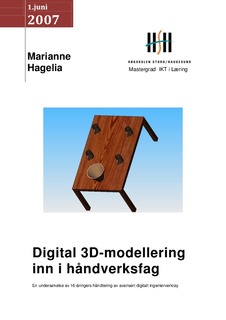| dc.description.abstract | Kunnskapsløftet (L06), which was implemented the autumn 2006, set forth target levels related to digital tools. There are great challenges related to implementing ICT in everyday school, both in organization and in pedagogy. The topic of this master essay is students’ learning and appropriation of software. The essay follows the introduction of new software in 3D-modelling in the professional program of Design and handicraft in upper secondary education. To get an understanding of the students’ learning is when they are going to absorb new software and how they appropriate the software has been an articulate goal. The problem to discussion is Digital 3D-modelling into professional handicraft. How do students usurp new tools for 3D-modelling? What characterizes the process of learning in the training of software? To what degree do students attain appropriation of the tool, and what characterizes the process of appropriation? How does the students’ digital competence didactically challenge their teachers?
A socio-cultural perspective is a backstage for this essay. Because of the complicated process of learning, theories are necessary to understand what happens when a student learns. As a vantage point for explaining the student’s level of reflection in the process of learning, I have chosen to use the systematic theory of learning developed by Gregory Bateson. To see whether the student experiences a productive or reproductive learning I have used Yrjö Engeström. He has elaborated further on Bateson’s levels of learning and developed a model for expansive theory of learning. A theory that demonstrates the student’s process of appropriation is taken from Roger Säljö. In the analysis of the material, I have chosen to use interaction analysis (Jordan & Henderson, 1995) as a tool for the analysis of video data. The aim of using interaction analysis has been to develop an understanding of what was really and concretely going on in the interaction between the student and the program, on the premises of the interaction itself. In the analysis I have looked at how the students handled new software, in order to see what we as teachers are unable to recognize in busy everyday school work.
I have found that the student’s digital competence is important in the process of learning. They move between conscious and non-conscious learning throughout the period. The students use | en |
